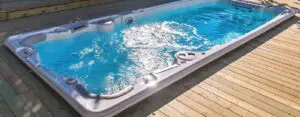November 19, 2025
Category: Hot Tub
Specs don’t loosen a tight neck. You want a home hot tub that starts quickly on a weeknight and feels good every time. Use the same checks we run in the showroom and a fast wet‑test you can do in a few minutes. See our full home hot tub range to compare sizes and styles.
Which home hot tub features make a massage therapeutic?
Start by noticing where the water lands. When a seat supports your lumbar curve and lets your shoulders sit easy, jets reach muscle instead of bone. Walk the body from neck to feet: try a neck and shoulder seat, a mid‑back position, a deeper lumbar seat, then some foot action. Use the controls to raise or soften flow until your breathing stays loose; if you brace, it is too strong. A smooth, quiet system feels like steady pressure, not “needles”, and that’s what many people relax into.
Installer note: We check head‑to‑jet height on every seat. If a jet hits bone rather than muscle, that seat is unlikely to relax you after ten minutes.
Do more jets in a home hot tub mean better therapy, or does placement matter more?
Placement beats count. A few well‑aimed jets can do more than a crowded setup that misses key areas. Neck and shoulder jets should reach the base of the skull. Mid‑back jets should sit beside the spine, not on it. Deeper seats should let you settle into the lumbar and glutes without floating. As pumps ramp, pressure should blend rather than spike; sharp, “spiky” pressure usually means the plumbing is not balanced. If a spot feels bony, nudge the jet angle a few degrees and feel the change.
You don’t need the biggest jet count to get great therapy our affordable luxury hot tubs focus on placement and flow that feel good.
Capability checks during your home hot tub wet test
- Open one seat. Do others keep steady pressure? If they drop, the plumbing isn’t well balanced.
- Can you micro‑adjust air/water per seat without spiky pressure?
Bring a small towel. Fold it under your neck if a seat needs a touch of height. Unusual access, specific seat heights, or a custom jet map? Our bespoke hot tubs programme can tailor the fit.
What home hot tub seat types help most: lounge, deep bucket or cool‑down?
Start with the lounge for full‑body support. If you float, cross ankles or press heels; if you still float, switch to the deep bucket for upright, secure work on back and glutes. Finish on a cool‑down perch to step your temperature down. Short five‑minute evening sits fit well here. If you want compact shells with supportive ergonomics, look at our Serenity hot tubs.
How does water flow in a home hot tub affect therapy?
You can also browse our home hot tub collection to compare designs with different jet layouts and pumps.
Flow quality matters more than power. You want delivery that stays stable as different seats open, and that you can fine‑tune per seat. Start low, then step up until muscles soften without tensing. If opening one seat steals pressure from another, ask us to show you the balance settings; well‑plumbed tubs hold steady when you change seats. Once the water feels right, set time and temperature so you can repeat the routine during the week.
What temperature works best in a home hot tub for recovery and relaxation?
Many owners use the mid‑30s °C for general relaxation and short sessions a little warmer in winter, and stay within the 40 °C (104 °F) cap. For week one, try 36–37 °C for 10–15 minutes, then review how you slept and how your shoulders feel next day. Keep hydration simple: drink water before and after.
Sleep timing: Soak 60–120 minutes before bed to help you fall asleep faster and sleep more efficiently.
Training days: Gentle heat and buoyancy often help recovery and mobility. Keep heavy sessions separate and choose what helps you move and sleep better.
Home hot tub safety
- Keep water ≤40 °C (104 °F).
- Check water: Chlorine ≥3 ppm or Bromine 4–8 ppm, with balanced pH.
- Pregnancy: the NHS advises avoiding hot tubs due to overheating risk, so speak to your midwife/GP.
- Blood pressure/heart: if treated and stable, short soaks (~10 min) may be acceptable. Ask your doctor first.
With the basics covered, test seats the same way every time so you can compare them fairly.
Can a home hot tub routine help with lower‑back stiffness?
Short, comfortable sessions in warm water can help many people move more easily. Reviews of aquatic physical therapy report improvements in pain and function for chronic lower‑back pain, though study quality varies. Keep sessions brief, stay within safe temperatures, and focus on positions that let you relax rather than brace.
Does hot tub help for sore joints or arthritis?
Warm‑water exercise and gentle heat are often used to ease joint stiffness and support range of motion in osteoarthritis. Systematic reviews show benefits for pain, stiffness and walking ability versus non‑exercise controls. Keep the water within safe limits and use seats that let you change position easily. If you have a diagnosed condition, ask your clinician for personal guidance.
Which features keep daily use easy, so you get the benefits?
You’ll soak more when access and controls feel effortless. Watch for loud night filtration, heavy covers or buried controls. These stop daily use. A cover lifter and safe steps make access quick. Simple presets cut friction on busy evenings. Water that feels good on skin and quiet filtration make ownership easy. Prefer low‑maintenance care and quiet, automatic cleaning? Explore Hydropool Self‑Cleaning hot tubs.
Skin‑feel check
Ask to feel water from the live tub. Then use a strip: aim for Chlorine ≥3 ppm, Bromine 4–8 ppm, and pH 7.0–7.8. Harsh smell or stinging eyes usually mean imbalanced water, not “strong” water.
Standards note
Look for models that meet BS EN 17125:2018 safety requirements for domestic hot tubs. Ask which aspects the model complies with.
What should you try during a wet test to compare therapy seats?
When you test a home hot tub, bring swimwear and a small towel. Ask us to set three presets (light, medium and firm) and show you how to throttle a single seat without starving the others. Then run this simple circuit for 2 minutes each: neck/shoulders; mid‑back; lumbar; calves/feet; cool‑down perch.
After the circuit, rate comfort and note any spots that feel buzzy or tense. Good sessions typically leave you warm, loose and comfortable; if not, reduce pressure or time next round.
How HTSS can help you choose a home hot tub
Tell us where it hurts first (neck, lower back, calves) and we’ll set two seats and one pressure you can relax into tonight. We’ll then map a short zone path that fits your routine. If you prefer compact footprints, explore Serenity hot tubs; for targeted programmes and strong ergonomics, try Signature models and Hydropool Self‑Cleaning hot tubs with Zone Therapy.
Contact us to discuss your needs and explore the models that suit your space and goals.


